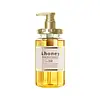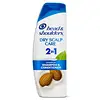What's inside
What's inside
 Key Ingredients
Key Ingredients

No key ingredients
 Benefits
Benefits

 Concerns
Concerns

 Ingredients Side-by-side
Ingredients Side-by-side

Water
Skin ConditioningLauramidopropyl Betaine
CleansingSodium C14-16 Olefin Sulfonate
CleansingSodium Lauroyl Taurate
CleansingGlycerin
HumectantCocamide DEA
EmulsifyingTea-Lauroyl Methylaminopropionate
CleansingTea-Cocoyl Glutamate
CleansingParfum
MaskingPolyquaternium-10
Sodium Benzoate
MaskingMyristyl Betaine
CleansingPhenoxyethanol
PreservativeCitric Acid
BufferingDisodium EDTA
Polyquaternium-47
Skin ConditioningMenthol
MaskingCaramel
Cosmetic ColorantHoney
HumectantArginine
MaskingPanthenol
Skin ConditioningArgania Spinosa Kernel Oil
EmollientShea Butter Glycereth-8 Esters
CleansingButylene Glycol
HumectantGluconobacter/Honey Ferment Filtrate
Skin ConditioningPPG-7
Skin ConditioningAcacia Senegal Gum
MaskingHoney Extract
HumectantCoco-Glucoside
CleansingKeratin
Skin ConditioningHydrolyzed Honey Protein
Skin ConditioningRoyal Jelly Extract
Skin ConditioningPaeonia Officinalis Flower Extract
TonicPropolis Extract
Skin ConditioningHydrolyzed Silk
HumectantHydroxypropyltrimonium Hyaluronate
Methylchloroisothiazolinone
PreservativeMethylisothiazolinone
PreservativePotassium Sorbate
PreservativeMagnesium Nitrate
Magnesium Chloride
Water, Lauramidopropyl Betaine, Sodium C14-16 Olefin Sulfonate, Sodium Lauroyl Taurate, Glycerin, Cocamide DEA, Tea-Lauroyl Methylaminopropionate, Tea-Cocoyl Glutamate, Parfum, Polyquaternium-10, Sodium Benzoate, Myristyl Betaine, Phenoxyethanol, Citric Acid, Disodium EDTA, Polyquaternium-47, Menthol, Caramel, Honey, Arginine, Panthenol, Argania Spinosa Kernel Oil, Shea Butter Glycereth-8 Esters, Butylene Glycol, Gluconobacter/Honey Ferment Filtrate, PPG-7, Acacia Senegal Gum, Honey Extract, Coco-Glucoside, Keratin, Hydrolyzed Honey Protein, Royal Jelly Extract, Paeonia Officinalis Flower Extract, Propolis Extract, Hydrolyzed Silk, Hydroxypropyltrimonium Hyaluronate, Methylchloroisothiazolinone, Methylisothiazolinone, Potassium Sorbate, Magnesium Nitrate, Magnesium Chloride
Zinc Pyrithione 1%
AntiseborrhoeicDimethiconol
EmollientWater
Skin ConditioningDimethicone
EmollientSodium Laureth Sulfate
CleansingSodium Benzoate
MaskingSodium Lauryl Sulfate
CleansingGuar Hydroxypropyltrimonium Chloride
Skin ConditioningCocamidopropyl Betaine
CleansingTea-Dodecylbenzenesulfonate
CleansingSodium Xylenesulfonate
Trideceth-10
CleansingZinc Carbonate
Magnesium Carbonate Hydroxide
BufferingGlycol Distearate
EmollientPrunus Amygdalus Dulcis Oil
Skin ConditioningParfum
MaskingBenzyl Alcohol
PerfumingSodium Chloride
MaskingMethylchloroisothiazolinone
PreservativeMethylisothiazolinone
PreservativeZinc Pyrithione 1%, Dimethiconol, Water, Dimethicone, Sodium Laureth Sulfate, Sodium Benzoate, Sodium Lauryl Sulfate, Guar Hydroxypropyltrimonium Chloride, Cocamidopropyl Betaine, Tea-Dodecylbenzenesulfonate, Sodium Xylenesulfonate, Trideceth-10, Zinc Carbonate, Magnesium Carbonate Hydroxide, Glycol Distearate, Prunus Amygdalus Dulcis Oil, Parfum, Benzyl Alcohol, Sodium Chloride, Methylchloroisothiazolinone, Methylisothiazolinone
 Reviews
Reviews

Ingredients Explained
These ingredients are found in both products.
Ingredients higher up in an ingredient list are typically present in a larger amount.
MCI is a preservative and known skin-irritant. It has anti-bacteria anti-fungal properties.
Studies spanning several decades have shown this ingredient to cause skin irritation and allergies.
MCI is commonly combined with methylisothiazolinone (MI). Other names for this mixture include Kathon CG and Euxyl K 100.
The use of this ingredient varies around the world:
Learn more about MethylchloroisothiazolinoneMI is a preservative and known skin irritant. In the past, MI was used for its ability to prevent bacteria, yeast, and fungi growth in low doses.
Nowadays, you'll most likely see MI combined with Methylchloroisothiazolinone (MCI). Trade names for this combination include Kathon CG or Euxyl K 100.
Since then, numerous studies have shown this ingredient to cause contact dermatitis, or skin irritation.
The use of this ingredient varies around the world:
Learn more about MethylisothiazolinoneParfum is a catch-all term for an ingredient or more that is used to give a scent to products.
Also called "fragrance", this ingredient can be a blend of hundreds of chemicals or plant oils. This means every product with "fragrance" or "parfum" in the ingredients list is a different mixture.
For instance, Habanolide is a proprietary trade name for a specific aroma chemical. When used as a fragrance ingredient in cosmetics, most aroma chemicals fall under the broad labeling category of “FRAGRANCE” or “PARFUM” according to EU and US regulations.
The term 'parfum' or 'fragrance' is not regulated in many countries. In many cases, it is up to the brand to define this term.
For instance, many brands choose to label themselves as "fragrance-free" because they are not using synthetic fragrances. However, their products may still contain ingredients such as essential oils that are considered a fragrance by INCI standards.
One example is Calendula flower extract. Calendula is an essential oil that still imparts a scent or 'fragrance'.
Depending on the blend, the ingredients in the mixture can cause allergies and sensitivities on the skin. Some ingredients that are known EU allergens include linalool and citronellol.
Parfum can also be used to mask or cover an unpleasant scent.
The bottom line is: not all fragrances/parfum/ingredients are created equally. If you are worried about fragrances, we recommend taking a closer look at an ingredient. And of course, we always recommend speaking with a professional.
Learn more about ParfumSodium Benzoate is a preservative. It's used in both cosmetic and food products to inhibit the growth of mold and bacteria. It is typically produced synthetically.
Both the US FDA and EU Health Committee have approved the use of sodium benzoate. In the US, levels of 0.1% (of the total product) are allowed.
Sodium benzoate works as a preservative by inhibiting the growth of bacteria inside of cells. It prevents the cell from fermenting a type of sugar using an enzyme called phosphofructokinase.
It is the salt of benzoic acid. Foods containing sodium benzoate include soda, salad dressings, condiments, fruit juices, wines, and snack foods.
Studies for using ascorbic acid and sodium benzoate in cosmetics are lacking, especially in skincare routines with multiple steps.
We always recommend speaking with a professional, such as a dermatologist, if you have any concerns.
Learn more about Sodium BenzoateWater. It's the most common cosmetic ingredient of all. You'll usually see it at the top of ingredient lists, meaning that it makes up the largest part of the product.
So why is it so popular? Water most often acts as a solvent - this means that it helps dissolve other ingredients into the formulation.
You'll also recognize water as that liquid we all need to stay alive. If you see this, drink a glass of water. Stay hydrated!
Learn more about Water